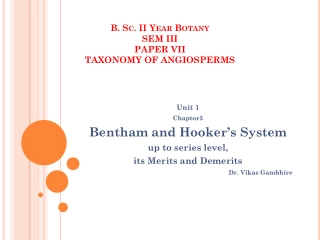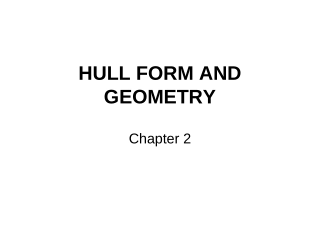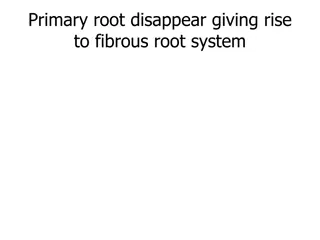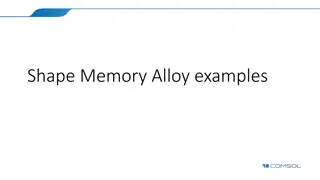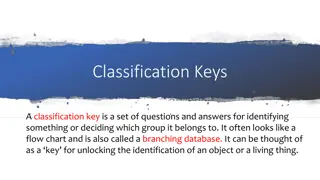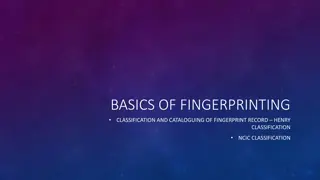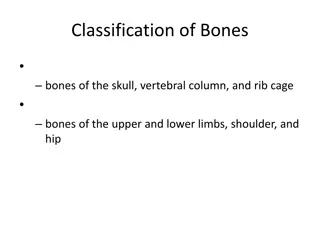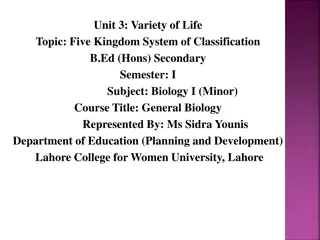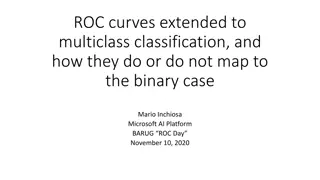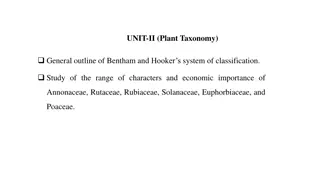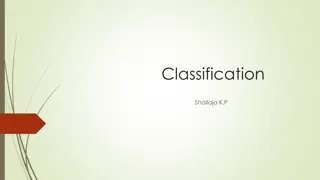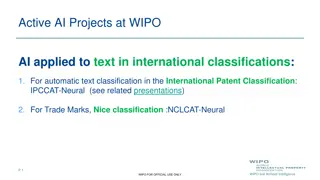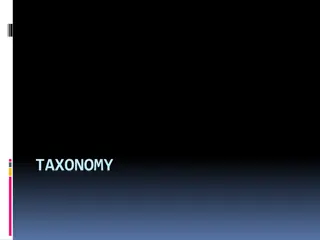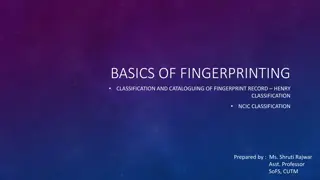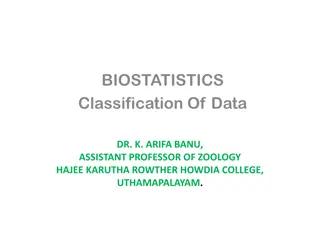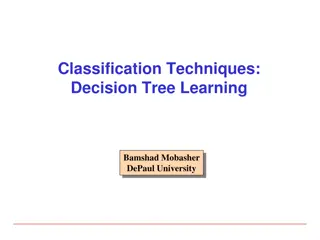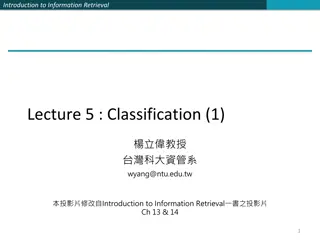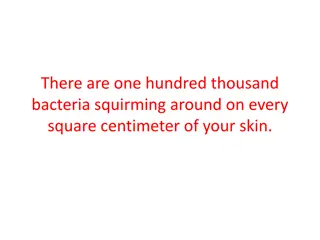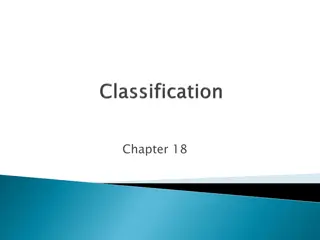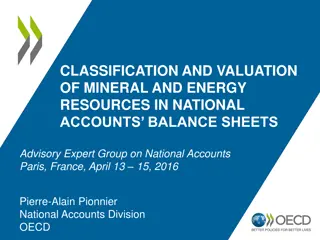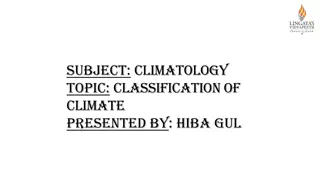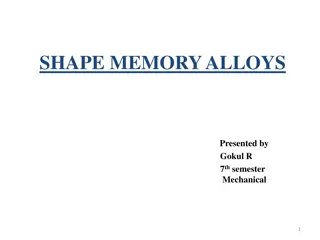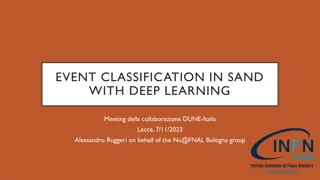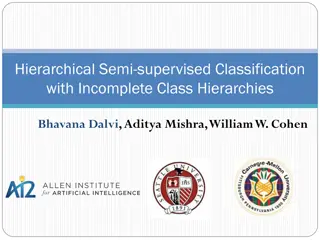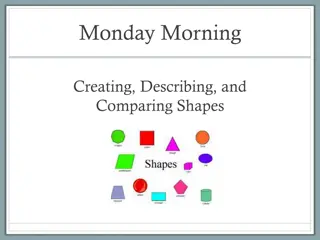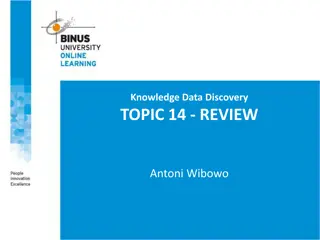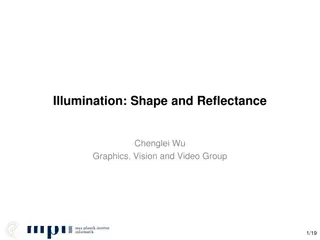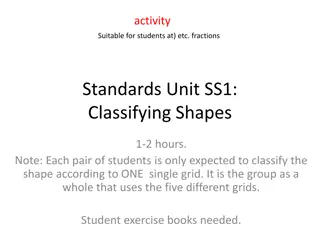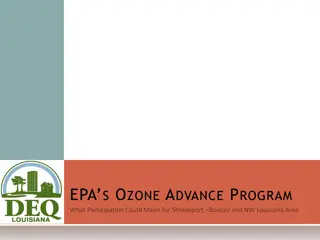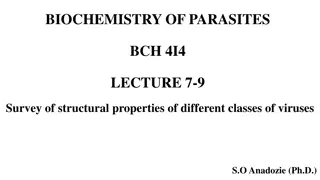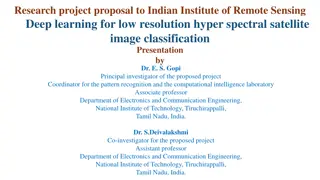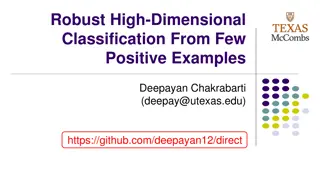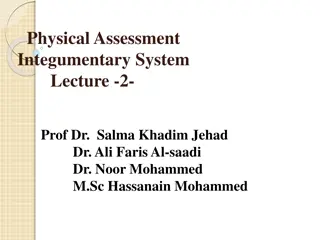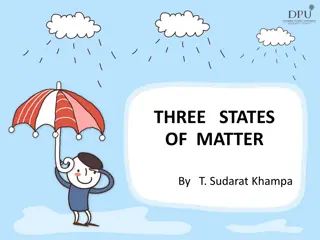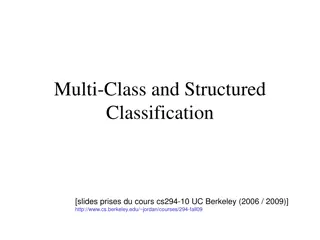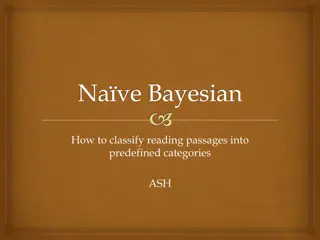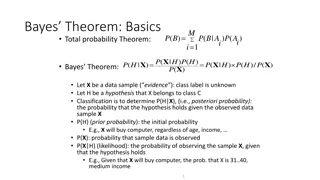Bentham and Hooker's System of Classification in Botany
Bentham and Hooker's system of classification in botany is a natural system based on a large number of characters considered simultaneously. Proposed by British taxonomists George Bentham and Joseph Dalton Hooker, this system categorizes seed plants into classes, orders, families, and genera. It is
2 views • 10 slides
Ship Classification and Design Factors Overview
Explore the categorization and classification of ships based on usage and support type. Delve into the factors influencing ship design such as size, speed, payload, range, seakeeping, maneuverability, stability, and special capabilities. Learn about the various methods of ship classification, includ
8 views • 104 slides
Plant Classification and Nomenclature Explained
Understanding plant classification through taxonomy, identification, and naming processes. Learn about the botanical structures such as roots, venation patterns, flowers, and vascular bundles. Explore the principles of binomial nomenclature, genus, and species differentiation. Discover the diverse s
3 views • 159 slides
Shape Memory Alloys: Properties and Applications
Shape memory alloys exhibit unique properties based on transformations between austenite and martensite phases. These transformations can be induced thermally or mechanically, leading to phenomena such as pseudoelasticity and shape memory effect. Learn about the thermal transformation, pseudoelastic
3 views • 9 slides
Classification Keys for Identifying and Sorting Things
A classification key is a tool with questions and answers, resembling a flow chart, to identify or categorize things. It helps in unlocking the identification of objects or living things. Explore examples like the Liquorice Allsorts Challenge and Minibeast Classification Key. Also, learn how to crea
3 views • 6 slides
Basics of Fingerprinting Classification and Cataloguing
Fingerprint classification is crucial in establishing a protocol for search, filing, and comparison purposes. It provides an orderly method to transition from general to specific details. Explore the Henry Classification system and the NCIC Classification, and understand why classification is pivota
5 views • 18 slides
Bones: Classification, Functions, and Markings
Explore the classification of bones based on shape, learn about the functions of bones in supporting the body and protecting vital organs, and understand the different bone markings that serve as attachment sites and joint formations.
1 views • 34 slides
Five Kingdom Classification in Biology: An Overview
The five kingdom system of classification, proposed by R.H. Whittaker in 1969, categorizes living organisms into Monera, Protista, Fungi, Plantae, and Animalia based on their characteristics. Each kingdom represents a distinct group of organisms, aiding in a more scientific and natural classificatio
2 views • 7 slides
ROC Curves in Multiclass Classification
ROC curves are extended to multiclass classification to evaluate the performance of models in scenarios such as binary, multiclass, and multilabel classifications. Different metrics such as True Positive Rate (TPR), False Positive Rate (FPR), macro, weighted, and micro averages are used to analyze t
3 views • 8 slides
Overview of Bentham and Hooker's Classification System in Plant Taxonomy
Bentham and Hooker's system of classification in plant taxonomy, outlined in Genera Plantarum, provided detailed descriptions of families and genera based on original plant dissections. This classification system has practical value for plant identification, with keys for taxa and subdivisions for l
4 views • 47 slides
Classification in Data Analysis
Classification is a key form of data analysis that involves building models to categorize data into specific classes. This process, which includes learning and prediction steps, is crucial for tasks like fraud detection, marketing, and medical diagnosis. Classification helps in making informed decis
2 views • 72 slides
AI Projects at WIPO: Text Classification Innovations
WIPO is applying artificial intelligence to enhance text classification in international patent and trademark systems. The projects involve automatic text categorization in the International Patent Classification and Nice classification for trademarks using neural networks. Challenges such as the av
2 views • 10 slides
Taxonomy and Scientific Classification
Explore the world of taxonomy and scientific classification, from the discipline of classifying organisms to assigning scientific names using binomial nomenclature. Learn the importance of italicizing scientific names, distinguish between species, and understand Linnaeus's system of classification.
0 views • 19 slides
Overview of Fingerprint Classification and Cataloguing Methods
Explore the basics of fingerprint classification, including Henry Classification and NCIC Classification systems. Learn about the importance of classification in establishing protocols for searching and comparison. Discover the components of Henry Classification, such as primary, secondary, sub-seco
1 views • 21 slides
BioStatistics: Classification of Data and Tabulation
BioStatistics involves the classification of data into groups based on common characteristics, allowing for analysis and inference. Classification organizes data into sequences, while tabulation systematically arranges data for easy comparison and analysis. This process helps simplify complex data,
0 views • 12 slides
Introduction to Decision Tree Classification Techniques
Decision tree learning is a fundamental classification method involving a 3-step process: model construction, evaluation, and use. This method uses a flow-chart-like tree structure to classify instances based on attribute tests and outcomes to determine class labels. Various classification methods,
5 views • 20 slides
Text Classification in Information Retrieval
This content delves into the concept of text classification in information retrieval, focusing on training classifiers to categorize documents into predefined classes. It discusses the formal definitions, training processes, application testing, topic classification, and provides examples of text cl
0 views • 57 slides
Bacteria: Classification and Characteristics Explained
Explore the world of bacteria with details on their shapes, structures, classifications into Eubacteria and Archaebacteria, differences between the two domains, and the classification based on characteristics like shape, cell wall makeup, energy source, and reproduction. Discover the fascinating rea
0 views • 45 slides
Taxonomy and Classification in Biology
Scientists use classification to group organisms logically, making it easier to study life's diversity. Taxonomy assigns universally accepted names to organisms using binomial nomenclature. Carolus Linnaeus developed this system, organizing organisms into species, genus, family, order, class, phylum
0 views • 11 slides
Mineral and Energy Resources Classification and Valuation in National Accounts Balance Sheets
The presentation discusses the classification and valuation of mineral and energy resources in national accounts balance sheets, focusing on the alignment between the System of Environmental-Economic Accounting (SEEA) and the System of National Accounts (SNA) frameworks. It highlights the need for a
0 views • 17 slides
Climate Classification Systems
Climatology explores the classification of climates based on vegetation distribution, average temperatures, precipitation patterns, and seasonal variations. This system categorizes climates into groups like tropical, dry, mild temperate, continental, and polar. Each group further delineates specific
0 views • 8 slides
Indiana School Mental Health Initiative Overview
The Indiana School Mental Health Initiative aims to improve mental health in schools through various activities, such as behavior consultation, community support, workshops, and SHAPE program implementation. SHAPE, a free system, helps schools assess and enhance their mental health services for acco
0 views • 14 slides
Introduction to Shape Memory Alloys and Their Applications
Shape memory alloys are unique metal alloys that can recover their original shape when heated above a certain temperature. This seminar covers the history, characteristics, advantages, and limitations of shape memory alloys, along with their popular commercial applications. The shape memory effect a
1 views • 16 slides
Event Classification in Sand with Deep Learning: DUNE-Italia Collaboration
Alessandro Ruggeri presents the collaboration between DUNE-Italia and Nu@FNAL Bologna group on event classification in sand using deep learning. The project involves applying machine learning to digitized STT data for event classification, with a focus on CNNs and processing workflows to extract pri
0 views • 11 slides
Hierarchical Semi-Supervised Classification with Incomplete Class Hierarchies
This research explores the challenges and solutions in semi-supervised entity classification within incomplete class hierarchies. It addresses issues related to food, animals, vegetables, mammals, reptiles, and fruits, presenting an optimized divide-and-conquer strategy. The goal is to achieve semi-
1 views • 18 slides
Geometry and Shape Learning Through Visual Resources
Dive into a visually engaging journey of geometry and shape learning, exploring various concepts, activities, and standards. From creating and comparing shapes to understanding perimeters and areas, this content offers insights into how children develop their understanding of shapes. Delve into the
0 views • 26 slides
Classification in Data Mining
Classification in data mining involves assigning objects to predefined classes based on a training dataset with known class memberships. It is a supervised learning task where a model is learned to map attribute sets to class labels for accurate classification of unseen data. The process involves tr
0 views • 26 slides
Advanced Techniques in Shape and Illumination Analysis
Exploring cutting-edge methods such as shape recovery from varying illumination and viewpoint, dynamic shape refinement from multi-view video, and depth estimation through photometric stereo constraints. The process involves factorization, compute depth maps, normal field calculations, and final sur
0 views • 13 slides
Engaging Students in Shape Classification Activity
Engage students in a 1-2 hour activity focused on classifying shapes, where pairs work together to classify shapes according to specific criteria using different grids. Consumable and reusable resources are required, along with printouts on pale-colored cards. The activity involves writing, sticking
0 views • 17 slides
Overview of Hutchinson and Takhtajan's Plant Classification System
Hutchinson and Takhtajan, as presented by Dr. R. P. Patil, Professor & Head of the Department of Botany at Deogiri College, Aurangabad, have contributed significantly to the field of plant classification. John Hutchinson, a renowned British botanist, introduced a classification system based on princ
0 views • 20 slides
The EPA's Ozone Advance Program and Clean Air Act
The content covers key information about the EPA's Ozone Advance Program, including the basics of ozone, the Clean Air Act requirements, designation vs. classification, classification deadlines, and marginal classification requirements. It explains the formation of ozone, the importance of reducing
0 views • 40 slides
Survey of Structural Properties of Different Classes of Viruses
Viruses are small obligate intracellular parasites that require living hosts for multiplication. They lack ribosomes and metabolic enzymes, relying on host cells for replication. Viruses vary in size, shape, and genome organization, with classification based on morphology, physicochemical properties
0 views • 31 slides
Deep Learning for Low-Resolution Hyperspectral Satellite Image Classification
Dr. E. S. Gopi and Dr. S. Deivalakshmi propose a project at the Indian Institute of Remote Sensing to use Generative Adversarial Networks (GAN) for converting low-resolution hyperspectral images into high-resolution ones and developing a classifier for pixel-wise classification. The aim is to achiev
0 views • 25 slides
Robust High-Dimensional Classification Approaches for Limited Data Challenges
In the realm of high-dimensional classification with scarce positive examples, challenges like imbalanced data distribution and limited data availability can hinder traditional classification methods. This study explores innovative strategies such as robust covariances and smoothed kernel distributi
0 views • 10 slides
Physical Assessment of Integumentary System in a Medical Lecture
In this lecture, Prof. Dr. Salma Khadim Jehad and other medical experts discuss the inspection and palpation techniques used for assessing the integumentary system, focusing on the skin, hair, and nails. The assessment includes details on normal and abnormal findings related to color, shape, texture
0 views • 21 slides
THREE STATES OF MATTER
Matter, defined as anything with mass and volume, exists in three states: solids, liquids, and gases. Each state has distinct properties based on particle arrangement, energy, and distance between particles. Solids have a fixed shape and volume with particles in a tight pattern, while liquids take t
0 views • 34 slides
Multi-Class and Structured Classification
This presentation covers topics like basic classification in machine learning, structured classification, multi-class classification approaches, generative models, nearest neighbor, decision trees, and multi-label classification. It discusses various classification techniques and their applications
0 views • 45 slides
Introduction to Classification Trees: CART Algorithm Overview
Classification trees, specifically the CART (Classification and Regression Trees) algorithm, are powerful tools for analyzing data and making predictions. By recursively partitioning data based on predictor values, classification trees aim to create nodes that are as different as possible in terms o
0 views • 13 slides
Classifying Reading Passages into Categories with Naive Bayesian
Text classification involves assigning reading passages to predefined categories for purposes like spam detection, authorship identification, and sentiment analysis. This process includes document pre-processing, feature indexing, applying classification algorithms, and performance measurement. Pre-
0 views • 35 slides
Fundamentals of Bayes Theorem and Classification
Bayes Theorem is a powerful tool for probabilistic reasoning and classification tasks. It involves deriving posterior probabilities based on prior knowledge and observed data. This technique is essential in making predictions and maximizing the accuracy of classification models. Nave Bayes Classifie
0 views • 15 slides
